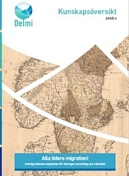This research overview provides a historical assessment of Swedish refugee and immigration policy during the 20th century. It answers questions such as: How did Sweden go from being a poor country of emigration to a rich country of immigration? How did Sweden cope with the refugee situation during WWII?
Some overall conclusions and recommendations
- It is obvious that immigration, both labor and refugee immigration as well as relatives of both of these groups, has meant a significant addition to Sweden's population and to the labor force. Immigrants have been and continue to be an important cog in Sweden's modern industrialization and in the construction of the welfare state.
- A common thread that has run throughout the history of immigration policy is the focus on concepts and labels of groups and the belief that the label changes themselves can have substantial effects on social development. Here we can mention the development from "foreigner" via "immigrants" to "foreign-born" and "newly arrived".
- From a European perspective, the Swedish attitude towards both labor and refugee immigration has been characterized by openness and generosity. The generous attitude to immigration has not meant that Sweden has had open borders.
- Another tension worth mentioning concerns the relationship between rights and obligations. Since the 1940s, the basic principle of the welfare system has been universalism, that is, that social rights encompass everyone, both domestic and foreign-born. Since the 1990s, the course has been changed in several ways. Demands and obligations rather than rights have been at the center, at least at the political level.
About the authors
The research overview, The history of immigration – from the ’people’s’ home to present-day Sweden (2917:5), is written by Pär Frohnert, associate professor of History, and Mikael Byström, associate professor of History at Uppsala University.
Picture by TheAndrasBarta from Pixabay.

